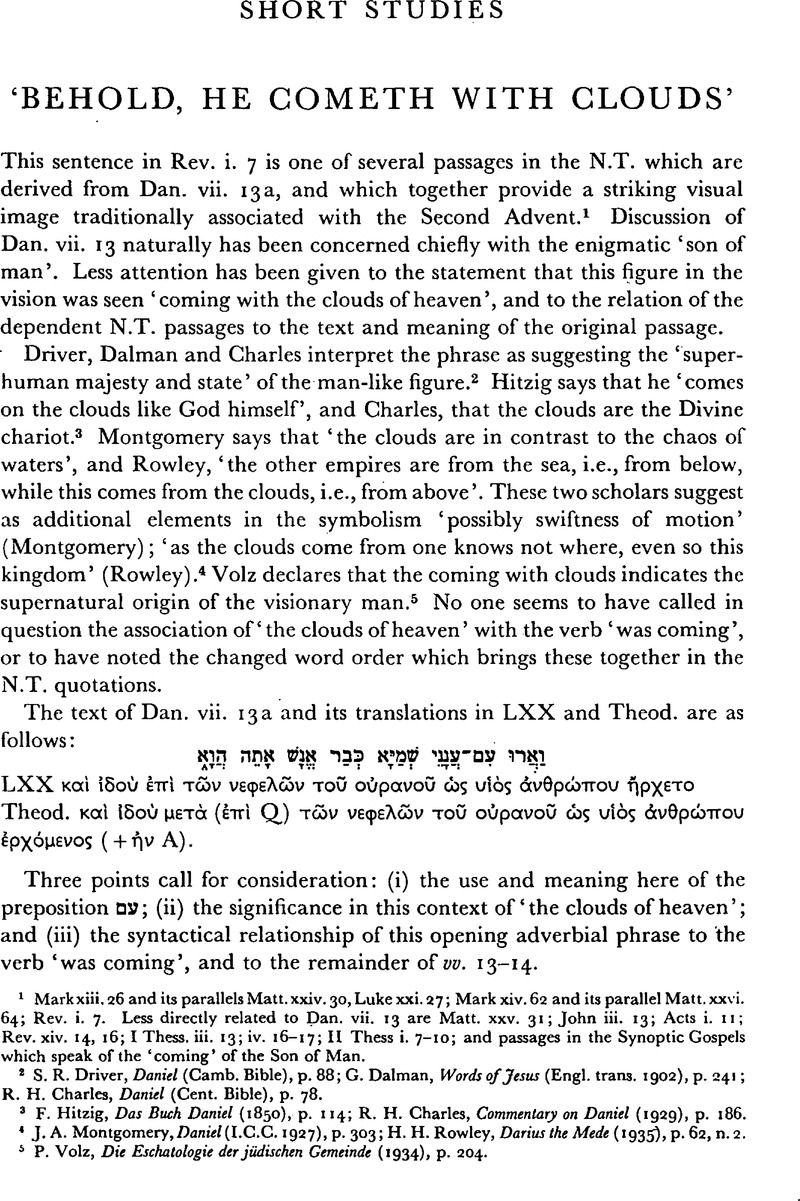Article contents
‘Behold, He Cometh with Clouds’
Published online by Cambridge University Press: 05 February 2009
Abstract

- Type
- Short Studies
- Information
- Copyright
- Copyright © Cambridge University Press 1959
References
page 127 note 1 Mark xiii. 26 and its parallels Matt. xxiv. 30, Luke xxi. 27; Mark xiv. 62 and its parallel Matt. xxvi. 64; Rev. i. 7. Less directly related to Dan. vii. 13 are Matt. xxv. 31; John iii. 13; Acts i. 11; Rev. xiv. 14, 16; I Thess. iii. 13; iv. 16–17; II Thess i. 7–10; and passages in the Synoptic Gospels which speak of the ‘coming’ of the Son of Man.Google Scholar
page 127 note 2 Driver, S. R., Daniel (Camb. Bible), p. 88; G. Dalman, Words of Jesus (Engl. trans. 1902), p. 241; R. H. Charles, Daniel (Cent. Bible), p. 78.Google Scholar
page 127 note 3 Hitzig, F., Das Buch Daniel (1850), p. 114;Google ScholarCharles, R. H., Commentary on Daniel (1929), p. 186.Google Scholar
page 127 note 4 Montgomery, J. A., Daniel (I.C.C. 1927), p. 303;Google ScholarRowley, H. H., Darius the Mede (1935), p. 62, n. 2.Google Scholar
page 127 note 5 Volz, P., Die Eschatologie der jüdischen Gemeinde (1934), p. 204.Google Scholar
page 128 note 1 Montgomery, op. cit. p. 303.Google Scholar
page 128 note 2 Dalman, op. cit. p. 242.Google Scholar
page 128 note 3 Torrey, C. C., ‘Notes on the Aramaic Parts of Daniel’, Trans. Connecticut Acad. Arts Sri. (1909), p. 282;Google Scholarcf. Marti, K., Das Bach Daniel (1901), p. 53.Google Scholar
page 128 note 4 Bentzen, A., Das Buch Daniel (H.A.T. 1937), in loc., explains the meaning as ‘appears in the clouds’.Google ScholarYoung, E. J., Prophecy of Daniel (1949), p. 154, interprets ‘with’ as ‘on’ or ‘in’, and quotes Keil ‘surrounded by clouds’. Rowley, op. cit. p. 62 n. 1, says that the variants in N.T. and early quotations leave the question as to which is original ‘entirely open’. The point is rather that all variants are possible translations of DY as used in Daniel.Google Scholar
page 128 note 5 R.S.V. ‘birds of the air’.Google Scholar
page 129 note 1 Cf. Ezek. i. I, ‘the heavens were opened and I saw visions of God’; cf. also I Kings xxii. 19; John i. 51; Acts vii. 55–6; Rev. i. 4. In view of such passages, G. R. Beasley-Murray, Commentary on Mark Thirteen (1957), p. 91, in claiming that the scene of Dan. vii is on earth, and that in v. 22 the Ancient of Days comes down to earth, appears to mistake the essential nature of apocalyptic visions as the unveiling of the celestial world.Google Scholar
page 130 note 1 Enoch xlvi. 1–2, xlvii. 3, xlviii. 2, lxix. 27, 29.Google Scholar
page 130 note 2 Robinson, J. A. T., Jesus and his Coming (1957), p. 134, in saying that ‘the symbolism of the language of the clouds is the same’ (at the Transfiguration) ‘as in the scene of Dan. vii. 13’, fails to observe a necessary distinction. The cloud chariot which carried up to heaven the two witnesses in Rev. xi. 12, and Jesus at the Ascension (Acts i. 11, cf. Luke ix. 31), has its antecedents in the assumption of Enoch (Enoch xiv. 8) and ultimately in that of Elijah (II Kings ii. 1–12), rather than in the celestial clouds of Dan. vii. 13.Google Scholar
page 131 note 1 Mark xiii. 26, xiv. 62; Matt. xxiv. 30, xxvi. 64; Luke xxi. 27; Rev. i. 7.Google Scholar
page 131 note 2 Cf. Enoch xlviii. 2, ‘at that hour the Son of Man was named in the presence of the Lord of spirits’; lxix. 29, ‘for that Son of Man has appeared, and has seated himself on the throne of his glory’.Google Scholar
page 131 note 3 Colani, Appel, Welihausen, Lagrange and others; most recently Robinson, op. cit. p. 45 Cf. Beasley-Murray, op. cit. pp. 20 ff.Google Scholar
page 131 note 4 As is the throne scene in Ezek. i. 4–28.Google Scholar
page 131 note 5 Mark xiv. 62 and its parallels, and perhaps also Mark xiii. 26 and parallels.Google Scholar
page 131 note 6 So Clarke, W. K. Lowther, Divine Humanity (1936), p. 23;Google ScholarGlasson, T. F., Second Advent (1945), pp. 63–8; Robinson, op. cit. pp. 39–58.Google Scholar
page 131 note 7 Cf. Montgomery, op. cit. pp. 296–7.Google Scholar
page 131 note 8 Robinson, op. cit. p. 55, holds that Jesus thought of his role as that of the one who accuses or pleads before the throne, and that his designation as judge in virtue of the Resurrection was a later development in the thought of the Church. The influence of the Messianic application of Ps. ii may be seen here.Google Scholar
- 1
- Cited by


